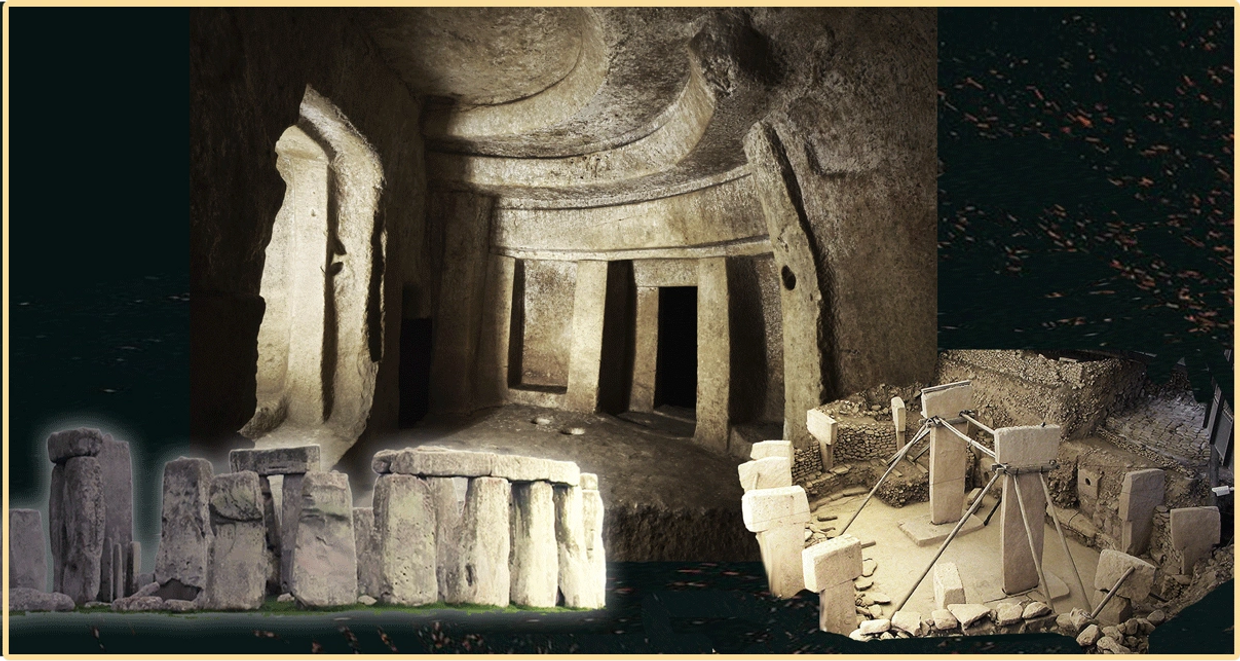PREHISTORY: Ancient Mediterranean and Levant

ONE THOUSAND STEPS & 12,000 YEARS!
That's what it took to bring humankind to western "civilization" as it is known in the 21st century.
If you're going to tell part of that story, you should understand the context from a variety of angles.
It's full of surprises, fraught with conflicting information and urban mythology.
The oldest buildings in the world: from Göbekli Tepe to Hal Saflieni to megalithic Stonehenge,
we have been there already, talking to folks and assembling solid scientific evidence since 1990.
ARCHAEOACOUSTICS (of course) * ARCHAEOLOGY * ARCHITECTURE * ETHNOMUSICOLOGY * EVOLUTIONARY ANTHROPOLOGY * GENETICS * NEUROSCIENCE * PHILOSOPHY * SOCIOLOGY * and more
Site photos, video, rare recorded interviews, studio sets, replicas, models, and half a ton of scientific reports
Scroll down to check out one of our projects.
A Megalithic Elephant in the Room
Monograph
Could humanity’s earliest monumental ritual spaces have shaped our mental health today? Drawing on archaeology, archaeoacoustics, population genetics, neuroscience, and anthropology, the monograph argues that the first sacred architectures — built over 11,000 years ago at sites such as Göbekli Tepe and Karahan Tepe — did more than organize ritual life. They altered human perception, reward systems, and social structures in ways that persist into the modern age.
By tracing these patterns through Anatolian farming populations into Europe and the Mediterranean on the way to the new world and beyond, the work connects ancient sound, architecture, and ritual to contemporary issues including addiction, spiritual dislocation, and social fragmentation. The monograph also introduces archaeoacoustic meditation, an experiential research method using authentic prehistoric acoustics to explore embodied memory and cognition.
At a time of escalating mental illness, hand-in-hand with technological acceleration, this work suggests that understanding our deepest past may be essential to navigating the future.

featuring authentic archaeoacoustic sound!
guided experiential narratives / Meditations
A new art form!
We've been calling them meditations. Actually, they’re immersive, sensorial, almost philosophical reenactments of human turning points — fusing archaeology, myth, and sound.
Original and extraordinary

Learning from the Stone Age
live presentation program
A highly innovative learning tool, designed and created with authentic normal human intelligence; presenting important prehistoric developments and the people of the time in a way that brings them to life in a sensible way a child can understand. Plenty of audio/visuals, discussion points and interactive exercises.

The Birth of Western Civilization
Feature Length Documentary Film
What if our ancient ancestors knew things that we have forgotten?
Introducing a stunning film that reaches deep into the past to recover a remedy for what ails the present, and inspires a brighter, happier future.
We know that cultures for thousands upon thousands of years passed their cultural norms, rites, and rituals along to younger generations by way of the oral tradition, which required strong listening skills and taught children the right ways to interact and to survive, as well as the correct ways to communicate within the culture or co-culture. This work appears to be a great jumping off point to return to the contexts and sensibilities that once ruled our human race and its array of cultural practices. We should all look deeper into the great potential of this project!
~
Dr. Larry Edmonds,
Professor Emeritus, Communication
College of Integrative Sciences and Arts
Arizona State University
It is critical that we support this study and that it be recognized as a helpful resource for the health of our cultures. Social media must be understood as a very thin presence, and one that this study can remedy.
~
Michael Purdy PhD Professor Emeritus, Communication Studies, Governors State U. Of IL.
As a former broadcaster, I know from experience the role that sound plays in our lives, whether in music, in spoken word, or in story-telling. Archaeoacoustic research is a promising area of inquiry: the study of what sounds have represented to the cultures of the past, as well as what they represent to present day cultures, offers fascinating and much-needed ways to understand who we are as human beings.
~
Donna L. Halper, PhD media historian, professor, author, public speaker 2023 Inductee, Massachusetts Broadcasters Hall of Fame
Archaeoacoustics is a promising new interdisciplinary initiative that is much needed in our times, when digital distraction and ambient noise are preventing children and people of all ages from developing a relationship with the reality around them. Besides drawing from several disciplines, it combines the ancient with the modern scientific to help humanity develop a continuum of communion with nature and one another.
~
Hal Swindall Professor of English, Woosong University, South Korea
Contact Us
Contact Us
The OTS Foundation for Neolithic Studies
Myakka City, Florida 34251, United States












OTSF is a United States of America not-for-profit 501(c)(3) foundation.
Copyright © 1994 The OTS Foundation - All Rights Reserved.
Visitors will not find any links to Social Accounts on this website. That's on purpose.